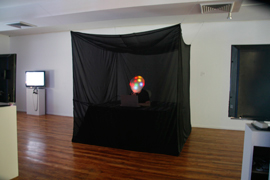This project was comprised of a series of experiments run during my thesis year at Parsons The New School for Design. In it’s final incarnation it was installed at the Chelsea Art Museum. The project was, in many ways, an extension of ideas I evolved based on my study of philosophical theories around mind, embodiment and the role of communication technologies and processes involved. The work was informed by the assumption that we were facing a similar, radical change in our human condition as was experienced during the baroque, brought about by the powerful and disruptive means of digital technologies and media; a kind of un/re/folding of the baroque.

At it’s core was a simple notion: I wished to create a system, an interface constructed around myself which would allow me to elevate my capabilities of expression, while fully detaching me from the outside world and the obligations to guide any of the responses given by the system.
For the outer shape of the installation I chose a black cube, which I divided into a 8x8x8 grid creating 512 cubic elements. The cube and more specifically a black cube plays a fundamental role and makes countless appearances in the history and development of our world of ideas and cultures. Using it as the form inside of which I would plant myself into the world felt highly appropriate. Similar to many of the nowadays screen-based devices it is often experienced as a somewhat uncanny, dehumanized object, yet it is one of the most prominent distinctly human creations which have occupied our minds and have subsequently come to dominate the built environment.
For the outer shape of the installation I chose a black cube, which I divided into a 8x8x8 grid creating 512 cubic elements. The cube and more specifically a black cube plays a fundamental role and makes countless appearances in the history and development of our world of ideas and cultures. Using it as the form inside of which I would plant myself into the world felt highly appropriate. Similar to many of the nowadays screen-based devices it is often experienced as a somewhat uncanny, dehumanized object, yet it is one of the most prominent distinctly human creations which have occupied our minds and have subsequently come to dominate the built environment.

HOW IT WORKED:
The helmet contained a video camera. Software I wrote enabled the live footage data captured by the camera to be read and manipulated. The response to this data was immediately reflected back to the viewer via a series of RGB LEDs embedded in the outer membrane of the helmet. A head mounted display and headphones integrated into the helmet allowed me to monitor the system of sensors and focus on personal development without the distractions of the outside world. Aleatoric compositions based on sound patterns perceived around the cube emanated from the installation.


A look inside during setup.
The helmet was inspired by the ability of cephalopods to change their skin in response to their environment. Languages as systems of communication can appear terribly limited once we consider the possibilities open to us if we were, for example, able to use our skin as a means to express the ideas that have formed in our minds without the need for intermediary processes to externalise these ideas.



A few shots of a prototype for a future incarnation of the cube. I devised a system to allow me to open and close the construction divided into cubic tiers along curved lines by means of pulling strings at two locations.


3D Renderings for a possible future iteration of the installation.
Excerpt from the sound envirnment created for the installation. Words from Friedrich Nietzsche's "Das Trunkene Lied".


